Nikkei from across the U.S. journey to Japan
to develop and strengthen their connections to Japanese culture.
By P.C. Staff
In January, 71 Nikkei and three chaperones traveled from the U.S. to Japan to participate in Kakehashi 2024, where they visited numerous historical and educational sites, experienced traditional and cultural activities and participated in lectures and workshops with the goal of building a mutual understanding between the U.S. and Japan for future friendship and cooperation.
(Read Part One of this story here.)
Divided into three groups, participants began their trip in Tokyo and then traveled on to Hiroshima and Okinawa, depending on their group destination assignment. This “once-in-a-lifetime dream trip” to Japan was made possible thanks to coordination by the JACL and the Japan International Cooperation Center (JICE) and supported by funding from the Japan Ministry of Foreign Affairs.
Following is Part II, personal trip reflections, from several of this year’s participants.
Lauren Iwamiya, Group B
“What makes you proud to be Japanese American?”
Kohei-san, one of our homestay hosts, asked this less than four hours into meeting us.
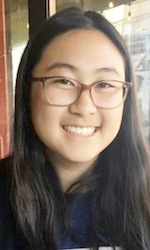
Lauren Iwamiya
In our more-than-broken Japanese and their equally steadfast attempts at speaking English, that was what we were talking about.
At the time, I was so astounded by the depth of the question and the fact that this could be asked in a space with little shared language, that all I said was, “I don’t know,” as I sat in stunned silence.
Throughout my time in Japan on the JACL Kakehashi Program 2024 trip, my understanding of what it means to be Nikkei was reshaped and continuously challenged.
As a Gosei Japanese Chinese American, I came into the experience slightly hesitant. I know that Japanese people living in Japan often invalidate the identity of Nikkei because of our distance from our Japanese roots. I was excited to meet my cohort on Kakehashi, but I was also afraid that being in Japan would make me feel more nationless.
Instead, I was enveloped by mutual understanding about what it means to be “Nikkei.” Everyone held such different cultural experiences, identities and lives, yet we all came together as Nikkei.
But what is it that connects us as Nikkei?
In Japanese American history, there are divisions within the Nikkei community that trace back to World War II and still stand today. My family was incarcerated in Tule Lake.
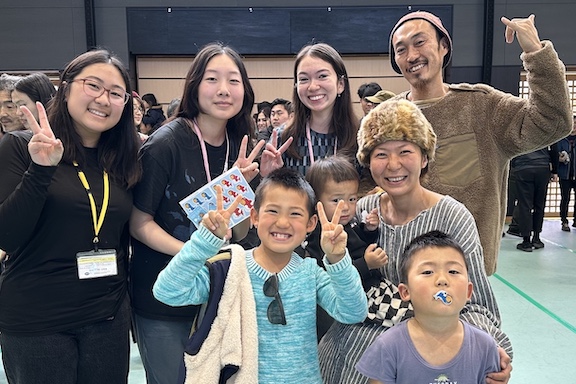
Lauren Iwamiya bids farewell to her homestay family. (Photos: Courtesy of Lauren Iwamiya)
I hold a great sense of pride in my family for checking No and No on questions 27 and 28 of the loyalty questionnaire. But so many Nikkei identify with the pride in their families for serving in the 442nd and in the Military Intelligence Service.
This is a pivotal divide in how Japanese Americans label Nikkei identity. I believe that my Nikkei identity lies in the fact that I belong neither in America nor Japan. I will never be Japanese enough for Japan, and America can never have my unbidden loyalty because they unconstitutionally forced my family into incarceration camps. On the other side, the Nikkei identity is proudly American because they proved their loyalty by laying their lives on the line for America despite their unjust treatment.
In spite of the chasm of how our families responded to WWII questions of American loyalty or how our families were not impacted by incarceration, everyone in my Kakehashi cohort connected under ganbatte and the struggle to negotiate our circumstances in the camps and in America. It is the struggle and pain, but also the celebration and deep pride for the perseverance of our ancestors.
At the closing of our homestay experience for Kakehashi, we performed the Bon Odori song “Ei Ja Nai Ka” for our homestay families. It means “Isn’t it good?” and celebrates the perseverance of our immigrant ancestors. “Ei Ja Nai Ka” represents where our pride in Japanese American identity lies. It is in a community that celebrates and honors our ancestors and their ganbatte spirit by embracing our heritage.
What makes us Nikkei — what makes us proud to be Nikkei — is ganbatte. And the people I met on Kakehashi helped me realize this.
Kenneth Kitahata, Group B
Throughout the 2024 Kakehashi Project, I looked for connections between growing up Japanese American in Hawaii and our weeklong trip through Tokyo, Hiroshima and Suō-Ōshima. For instance, friends on the trip shared moments of familiarity when our homestay family prepared chawanmushi (steamed egg) or as we slept on tatami mats. I saw many Nikkei values passed down by my family, like humility and politeness, reflected by the local Japanese community throughout the trip. Even barely speaking Japanese and being thousands of miles from home, these similar values made Japan feel so familiar.
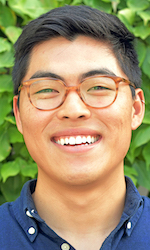
Kenneth Kitahata
As a young professional on the Kakehashi Project, I thought about how Japanese values like collectivism often feel at odds with working in corporate America where individual performance, speaking up and comfort with conflict are rewarded. I’ve always had a quieter style at work and never related to stereotypes of executives as fiery and charismatic. One time after getting questioned by a director on my team after presenting, I remember thinking I just had thin skin for criticism. But, I wanted to continue showing up authentically, especially working at an impact investor trying to reimagine capitalism.
These ideas around my Nikkei values continued to pop into my head as the trip to Japan approached and Kakehashi held an orientation on Japanese etiquette. We were introduced to Japanese culture through traditional tea ceremony values like Wa (harmony) and Kei (respect). Even if we didn’t speak Japanese, we could show respect by removing our shoes indoors or limiting noise while riding the train.
These values of harmony and respect reminded me of my own family, so I made it a point to ask my Kakehashi friends what Japanese sayings they grew up hearing. In Suō-Ōshima during our homestay, I learned of the saying, Deru kui wa utareru or “the nail that sticks out gets hammered down.” Something clicked for me hearing this Japanese proverb on conformity; I realized that my tendency toward respect and conflict aversion might be shaped by the country my great-grandparents emigrated from over a century ago.
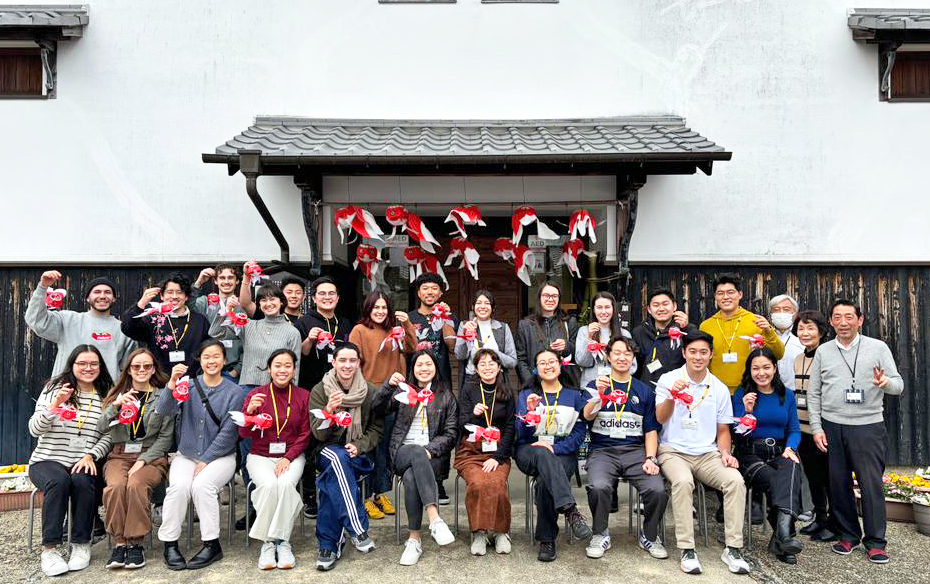
JACL Kakehashi Group B at the White Walls of Yanai. (Photo: Courtesy of Lauren Iwamiya)
Hearing my homestay family tell me about this nail-and-hammer proverb reminded me of the Japanese sayings I grew up with.
One I often heard at family dinners was enryo, when my dad would refuse the last piece of food out of politeness even when he was still hungry. This taught me that politeness means putting aside my wants. Even today, my partner often has to offer me the same thing twice before I accept it. Part of this restraint comes from the legacy of World War II incarceration when many Issei said shikata ga nai and endured countless hardships as they were stripped of their civil liberties. I wrote about my grandfather’s experience joining the 442nd Regimental Combat Team to prove his loyalty in the 2017 Go For Broke essay contest.
After returning from Kakehashi, I reflected on ways my Nikkei values of respect benefit me. At work, it makes me a team player and emphatic people manager as I’ve recently been able to hire and manage a data analyst. I’m also trying to become more comfortable with inevitable conflict in my relationships and at work, with my first step trying to recognize when I’m feeling flooded.
During our closing ceremony in Tokyo, I read a quote from previous Kakehashi participants that “we serve as Kakehashi by finding commonalities and also actually understanding each other well enough to meet in the middle.” The Kakehashi Project showed me the Japanese origin of my values of respect and humility growing up as a fourth-generation Japanese American.
It will continue being a learning journey to balance these values of collectivism and individualism by recognizing the influence of both Japan and America in my life. The Kakehashi Project has given me the wisdom of perspective in discerning between Nikkei and Japanese culture, and it simultaneously helped me discover that my strength to show up authentically is rooted in my diverse cultural values.
Yubi Mamiya, Group A
Standing on the sparkling beaches of Okinawa, I gazed in amazement at the expanse of soft, ivory sand. It was speckled with branching coral skeletons and intricate seashells. But these wonders were obscured by garbage.
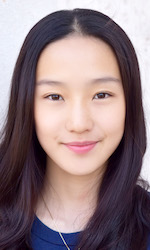
Yubi Mamiya
I picked up another chunk of seaweed-strewn Styrofoam and stuffed it into our overflowing bag of trash. Piece by piece, we slowly revealed the beauty buried beneath during the beach cleanup with Natural Blue for the 2024 Kakehashi Project.
Twelve million tonnes of plastic is dumped into the ocean every year. The United States and Japan rank No. 1 and 2 in terms of per-capita plastic-packaging waste emissions. Our nations have a collective responsibility to improve our waste management system, create innovative solutions to replace plastic and restore respect for the environment.
I was inspired to learn that Natural Blue is driving environmental stewardship by leading beach cleanups and educational lessons on global pollution for divers and visitors in Okinawa. They encourage us to care for our land and oceans by fostering a love for nature and opportunities to care for it.
We have much to learn from Okinawan communities on teaching environmental stewardship to young people. During my homestay at Yomitan Village for the 2024 Kakehashi Project, I had the remarkable opportunity to learn about and participate in sustainable farming practices alongside elementary school students.
On an early, humid morning, we learned how local farmers built greenbelts to prevent agricultural runoff. Their interactive demonstration modeled how rainfall washed nutrient-rich fertilizers into the ocean, where they led to eutrophication and death of marine life.
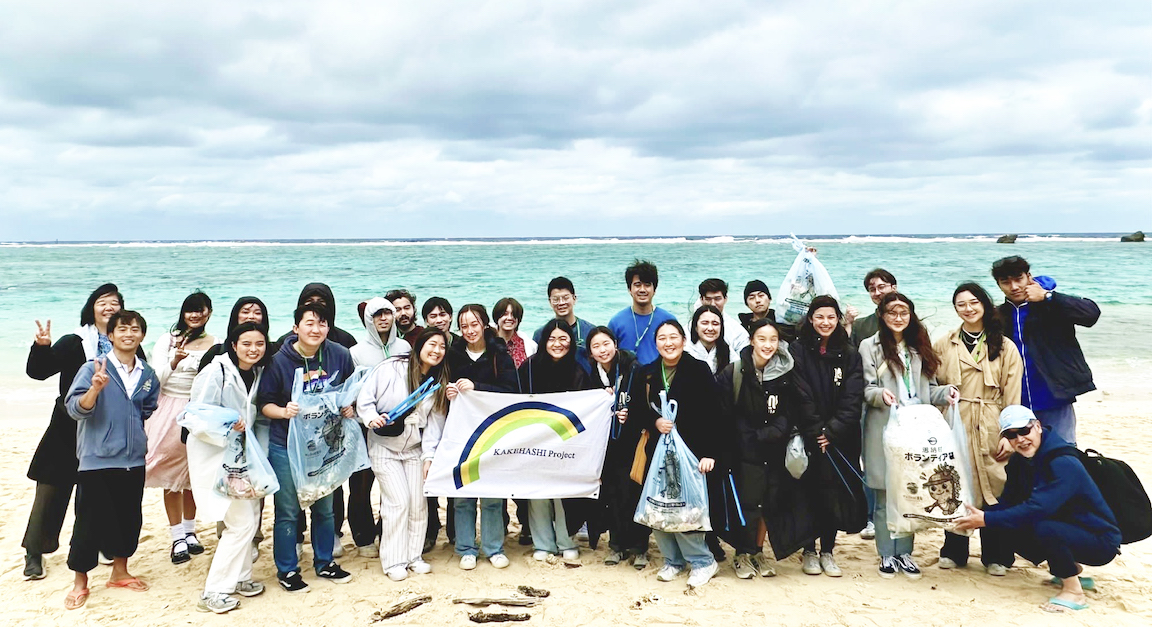
Members of the 2024 Kakehashi Project visited Natural Blue in Yomitan, Okinawa, to learn about the effects of plastic pollution on marine life and participated in a cleanup for a local beach. (Photos: Courtesy of Yubi Mamiya)
I was incredibly grateful for the support of the Kakehashi Project staff, who helped expand upon the farmers’ explanations in English and answered my curious questions about the creation of greenbelts. Who knew that the beautiful hibiscus flowers lining the roads blocked farm soil from polluting the surrounding lands? Or that the vetiver plant that was also a base note for Chanel No. 5 perfume could hold down nutrients and fertilizers during heavy rains? I was touched to see local children help plant vetiver greenbelts along the farms with such enthusiasm, a testament to the intimate relationship between Okinawans and their environment.
It is imperative that we foster U.S.-Japan collaborations between students, innovators and government leaders to promote environmental stewardship. My insightful discussions with the students at the University of Ryukyu for the 2024 Kakehashi Project opened my eyes to the diverse perspectives and experiences they contribute to the global conversation on sustainability.
We are eager to increase the impact of innovative solutions pioneered by Japanese companies, such as the development of plastic alternatives. Kaneka Biotechnology Research Labs is creating marine biodegradable plant oil pellets, and Nippon Paper Industries is coating their paper products with a biodegradable resin to replace plastic barrier films.
I look forward to working with Japanese and Japanese American young people to promote these innovative solutions around the world. Together, we can create a sustainable and beautiful future.
Naomi Suzuki, Group A
Despite having both a first and last Japanese name, I have always felt anything but. Born to a Korean immigrant mother and a fourth-generation Japanese American father, I grew up eating kim rather than nori, and tteok instead of mochi. The few Japanese words I did know were mostly Hawaiian slang, which is where my grandpa is from. See? I don’t even call my grandpa Oji-chan.
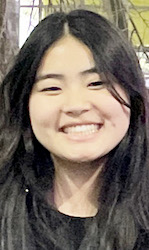
Naomi Suzuki
Because of this, when people would ask if I was Japanese, I would always respond, “I’m only half.” Only. As if I was implying that something is missing or that I am not fully Japanese American. In my head, saying I was Japanese felt like a lie.
When I started at UCLA, I joined the Nikkei Student Union and Kyodo Taiko to connect more with my JA side. Though I have learned about Japanese American culture through the community I found at school, I still felt out of place at times. Most of my new Japanese friends had grown up in the JA community and had many shared experiences I couldn’t relate to.
Before Kakehashi, I had never met another Gosei before, but when I made it to Japan, I found that so many of my peers were just like me. Many of us grew up with bits and pieces of Japanese culture but felt like we weren’t “Japanese enough.” Getting to experience Japan with young Japanese Americans who shared my experience is a huge part of what made this trip so special.
For a part of my Kakehashi experience, I visited Okinawa. While there, I participated in a homestay with three other girls from my cohort, and this ended up being a transformative experience for all of us. I felt truly immersed in Okinawan culture and got to see all the nuance and complexity of their society.
We learned how to play the sanshin, ate their famous purple sweet potato (beni imo) and learned some of the local dialect from Oji and Oba (our homestay parents). Despite Oji and Oba speaking almost no English, I found that we were still able to connect and create meaningful experiences. By the end of our stay, I felt like I was visiting my grandparents.
At one point during our trip, we visited a small farm with a bunch of Okinawan families where we learned about the importance of practicing environmentally conscious farming methods. We learned how fertilizer from the farms on the island will drain into the ocean, killing the surrounding coral.
In order to protect the surrounding reefs, Okinawan farmers implement a greenbelt where they plant certain plants around their farms to filter out the fertilizer as the water drains. Watching this community learn about how to protect their land and the surrounding oceans was incredibly powerful. In America, we place extreme value on individualism, but for many Asian American kids, we grow up instilled with values of community and family. Despite not speaking Japanese or going to Obon as a kid, I discovered that I resonate with other fundamental values represented in Japanese culture.
Okinawa is largely known for the American military base that takes up a big portion of their land, and before visiting, I thought the base was unwelcome and should be removed. But, after speaking to Oji and other Okinawans, I realized it has become a fundamental part of many of their lives. Having been there for so long, it provides many jobs for the Okinawan people, and without it, their economy would crumble.
One of the foods I ate at my homestay was a fusion dish called taco rice. It’s basically taco ingredients: tomatoes, lettuce, ground beef, cheese and hot sauce, but over rice instead of in a taco shell. It’s a popular dish in Okinawa and is representative of the huge influence of American culture on Okinawan people.
People still have mixed feelings about the base, including myself, but ultimately, it has become intertwined into Okinawan lives and culture. I realized the relationship between the U.S. and Japan is extremely multifaceted, but that’s why it is so important to make efforts to create connections and a shared community across our cultures. How else can we maintain strong connections without understanding each other’s experiences?
My Kakehashi journey instilled in me a profound pride in my Japanese heritage and fostered meaningful connections with my fellow participants. I will always be grateful for the endless “conbini” runs, long walks in Shibuya at night or doing a farewell Okinawan dance with our homestay families.
Now, when people ask me if I’m Japanese, I refrain from the reflexive “only half.” To be JA is to be a part of a diverse community where we each have our own definition of what it means to be Japanese American. I may be half-Japanese, but I am wholly Japanese American.
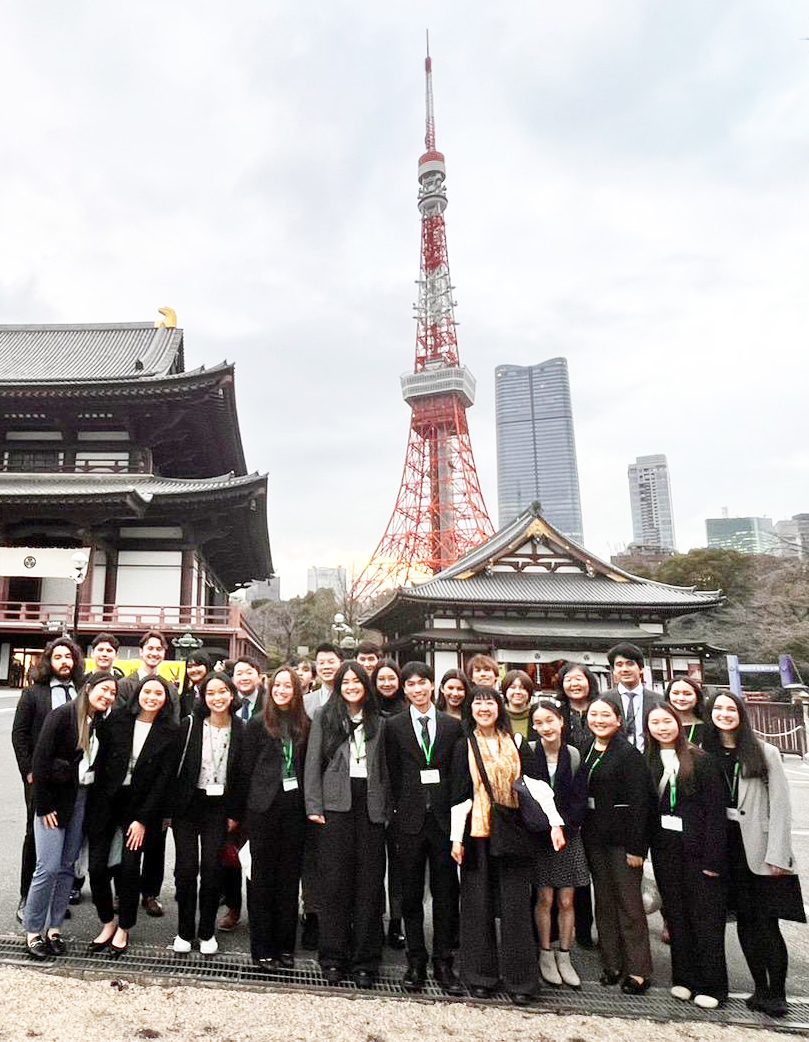
Kakehashi Group A (Okinawa) participants, JACL chaperone Julie Abo and JICE staff in front of the Tokyo Tower (Photo: Mikiko Yanase, Group A JICE coordinator)



